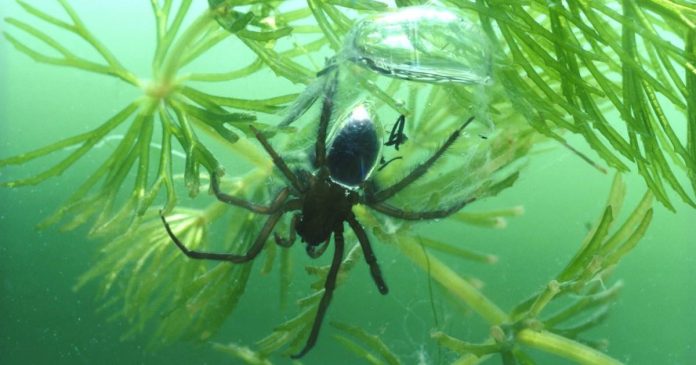Spiders are not just found on land, but also underwater. The diving bell spider, also known as the water spider, is able to live entirely underwater, from resting to catching prey and even mating. This unique spider can be found in popular holiday destinations along the south coast of England, as well as in Wales and the Lake District. It is also seen in Scandinavia and other top European holiday spots like France, Germany, and Switzerland.
To survive underwater, the diving bell spider needs oxygen. It surfaces briefly to replenish its oxygen supply by trapping air in a layer of waterproof hairs on its abdomen and legs, creating a bubble of oxygen in its underwater web. These spiders are commonly found in freshwater locations such as lakes, ponds, canals, and slow-moving streams throughout mainland Europe and northern Asia. In the UK, they prefer wetlands, lake edges, ponds, and rivers.
Although the diving bell spider is seen across Europe, it has not been spotted in Portugal, Greece, and Albania. In the UK, it can be found in Cornwall, the Lake District, Anglesey, and Bournemouth. In Europe, it has been sighted in cities like Munich and across Germany. Asia also has its own species of diving bell spider, known as A. a. japonica, which is identical to its European cousin but has larger genitals. These spiders can be found in ponds in Kyoto, Japan. In South Korea, the species is protected and has a dedicated habitat called the Yeoncheon Eundaeri water spider habitat.
In a surprising discovery, researchers have found that male diving bell spiders sometimes engage in reversed sexual cannibalism by eating their female partners. The likelihood of cannibalism was higher when females avoided larger mating partners. Additionally, large males and females were also observed killing smaller males.
Where can you find the water spider?
The water spider, also known as the diving bell spider, is found in various locations around the world. This unique spider has developed a fascinating survival technique.
How does the diving bell spider survive?
The diving bell spider creates a special silk-based structure that resembles a diving bell. It spins a web between underwater plants and then brings air from the surface down to its web. This web acts like a gill, extracting oxygen from the water, allowing the spider to only resurface once a day to replenish its oxygen supply.
The spider scrapes off the air into a bubble, which expands to an average size of 20mm. The spider can fit inside this bubble, and the air inside the diving bell is regularly refreshed. The oxygen levels in the bell remain stable as oxygen from surrounding water diffuses into it. The spider even carries a bubble of air trapped between its hydrophobic hairs, giving it a unique silvery, velvety coloration.
Differences between male and female diving bell spiders
Male diving bell spiders are larger and heavier than females. They have longer front legs, which help them move more efficiently underwater. On the other hand, females need to build bigger webs for their potential young, so they are smaller in size. They spend more energy frequently transferring fresh air from the water surface to the bell.
Are diving bell spiders dangerous to humans?
While diving bell spiders have a powerful bite and prey on small fish, they are not lethal to humans. However, their bite has been reported as painful. It’s important to note that the most venomous spider in the UK is a different species called the false widow.

